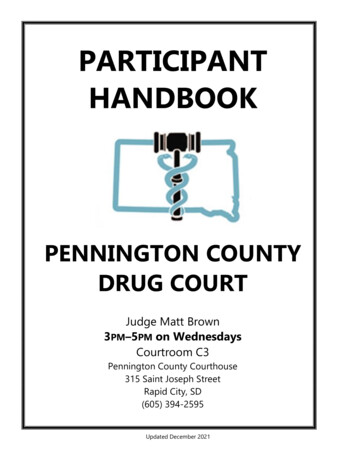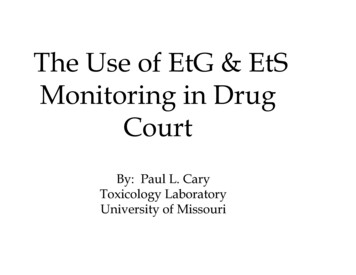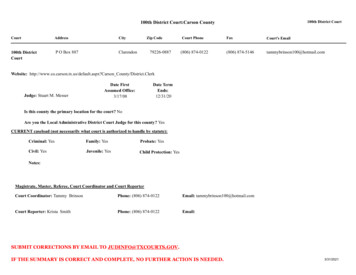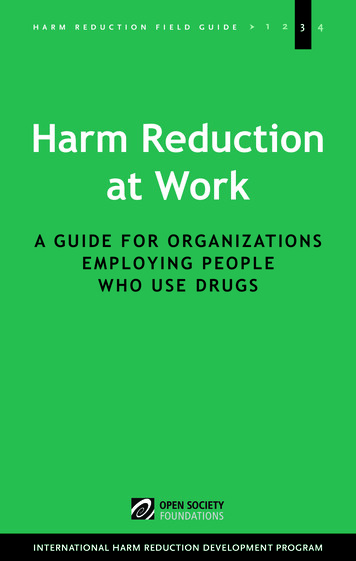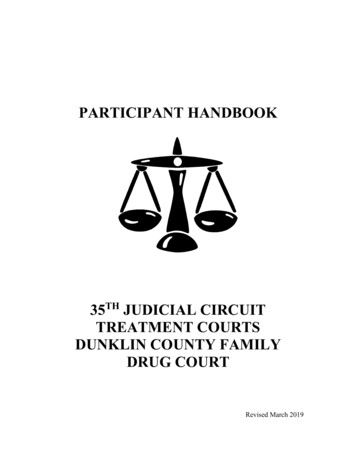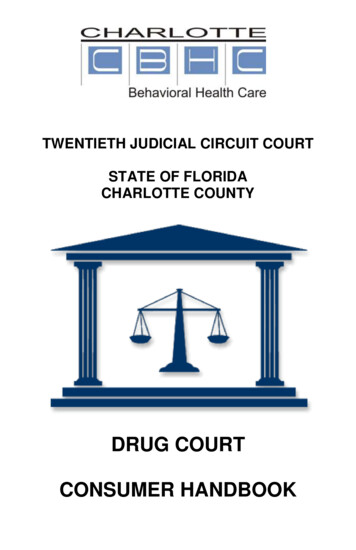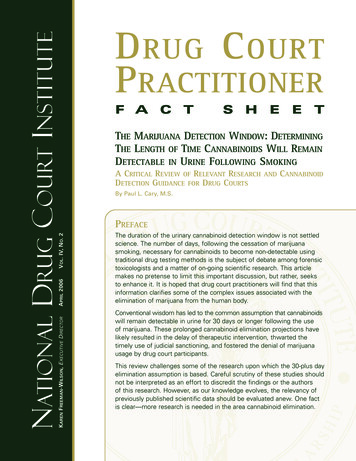
Transcription
F ACTSHEETTHE MARIJUANA DETECTION WINDOW: DETERMININGTHE LENGTH OF TIME CANNABINOIDS WILL REMAINDETECTABLE IN URINE FOLLOWING SMOKINGA CRITICAL REVIEW OF RELEVANT RESEARCHDETECTION GUIDANCE FOR DRUG COURTSANDCANNABINOIDBy Paul L. Cary, M.S.APRIL 2006VOL. IV, NO. 2PREFACEKAREN FREEMAN-WILSON, EXECUTIVE DIRECTORNATIONAL DRUG COURT INSTITUTED RUG C OURTPRACTITIONERThe duration of the urinary cannabinoid detection window is not settledscience. The number of days, following the cessation of marijuanasmoking, necessary for cannabinoids to become non-detectable usingtraditional drug testing methods is the subject of debate among forensictoxicologists and a matter of on-going scientific research. This articlemakes no pretense to limit this important discussion, but rather, seeksto enhance it. It is hoped that drug court practitioners will find that thisinformation clarifies some of the complex issues associated with theelimination of marijuana from the human body.Conventional wisdom has led to the common assumption that cannabinoidswill remain detectable in urine for 30 days or longer following the useof marijuana. These prolonged cannabinoid elimination projections havelikely resulted in the delay of therapeutic intervention, thwarted thetimely use of judicial sanctioning, and fostered the denial of marijuanausage by drug court participants.This review challenges some of the research upon which the 30-plus dayelimination assumption is based. Careful scrutiny of these studies shouldnot be interpreted as an effort to discredit the findings or the authorsof this research. However, as our knowledge evolves, the relevancy ofpreviously published scientific data should be evaluated anew. One factis clear—more research is needed in the area cannabinoid elimination.
NATIONAL D RUG COURT I NSTITUTEMerely attempting to formulate cannabinoiddetection guidance invites controversy. Somewill argue that the proposed detection windowdefined in this article is too short. Others willsuggest the opposite. Still others will insistthat the scientific evidence is insufficient toallow the establishment of such guidance.To some degree, each position has merit. Nodetection window guidance, regardless of theextent of scientific support, will encompassevery set of circumstances or all client situations.If nothing else, the research demonstrates thatthere is significant variability between individualsin the time required to eliminate drugs.These facts, however, should not precludethe development of reasonable and pragmaticguidance, supported by scientific research, foruse in the majority of drug court adjudications.It is widely accepted that in order to instillsuccessful behavioral changes in a substanceabusing population, that consequences needto be applied soon after the identification ofrenewed or continued drug use. In a drug courtcontext, the application of judicial sanctionsand the initiation of therapeutic interventionshave been needlessly delayed due to a lackof coherent guidance regarding the length oftime cannabinoids will likely remain detectablein urine following the cessation of marijuanasmoking. The purpose of this article is toprovide that much needed guidance.the cutoff calibrator for ten consecutive days.”Based upon these seemingly divergent findings,it is not difficult to comprehend why judges,attorneys and other drug court professionalsare in a quandary regarding the length of timemarijuana can remain detectable in urinefollowing use. The dilemma—if the scientificresearch seems not to be able to achieveconsensus on the urinary cannabinoid detectionwindow, how are those responsible for courtmandated drug supervision programs supposeto understand and resolve this issue?Like many other scientific and technical topicsthat have been thrust into the judicial environment, the detection window of marijuanais both complex and controversial, yet theunderstanding of the pharmacology of thispopular substance is crucial to the adjudicationof cases in which marijuana usage is involved.While the difficulties associated with establishing the length of time a drug will continueto test positive in urine after use are not uniqueto marijuana, the problem is exacerbated bythe extended elimination characteristics ofcannabinoids relative to other drugs of abuse,most notably after chronic use.The questions posed by drug court professionalsrelated to cannabinoid detection in urine include: How many days is it likely to take for a chronicmarijuana user to reach a negative urine drugtest result? How long can cannabinoids be excreted andINTRODUCTIONIn a recent forensic publication, Dr. MarilynHuestis wrote: “Monitoring acute cannabisusage with a commercial cannabinoidimmunoassay with a 50-ng/mL cutoff concentration provides only a narrow window ofdetection of 1–2 days,” (2002). In a 1985article by Ellis et. al., researchers concluded;“that under very strictly supervised abstinence, chronic users can have positive resultsfor cannabinoids in urine at 20 ng/mL orabove on the EMIT-d.a.u. assay 1 for as manyas 46 consecutive days from admission, andcan take as many as 77 days to drop below2detected in urine after a single exposure tomarijuana? How many days of positive urine drugtests for cannabinoids constitutes continuedmarijuana usage? How often should a client’s urine be testedto monitor for continued abstinence frommarijuana? How many days should the court wait beforeretesting a client after a positive urine drugtest for cannabinoids has been obtained? How should the court interpret a positiveurine drug test for cannabinoids after a clienthas completed an initial 30-day detoxificationperiod designed to “clean out” their system?
D RUG C OURT P RACTITIONERTo one degree or another, answering thesequestions depends upon the ability of the courtto estimate the length of time cannabinoidswill likely remain detectable in urine followingthe use of marijuana by a drug court client.Thus, the cannabinoid detection windowbecomes a determinative factor in the appropriate interpretation of urine drug testingresults for marijuana. The lack of adequateguidance has hindered the development ofthese standards for use in drug court.It is important to note that while courtsmay be seeking absolute answers (an exactcannabinoid detection window), the scienceof drug detection in urine can only providereasonable best estimates. The law is notalways black and white; neither is science.Therefore, precise “yes/no” answers orexact detection windows are generally notattainable. Sensible guidance for the interpretation of urine cannabinoid results by drugcourts, however, is achievable.FRAMING THE QUESTIONSimply put, the detection window is the lengthof time in days following the last substanceusage that sequentially collected urine sampleswill continue to produce positive drug testresults—in other words, the number of daysuntil last positive sample. This time period isnot the same as the length of time a drug willremain in someone’s system—that conceptis, in reality, indeterminable (given that thereis no analytical method capable of detectingthe presence of a single molecule of drug in adonor’s body). The question being addressedherein is not how long minute traces of marijuana will remain in a client’s tissues or fluidsafter smoking, but rather how long thoseresidual cannabinoid metabolites will continueto be excreted in urine in sufficient quantitiesto produce a positive drug test (by standardscreening and confirmation testing).FA C TS H E E TStudy subjects with exceptionally longcannabinoid detection times (30-plusdays) were just that-exceptional.For those compounds with uncomplicatedmetabolic pathways or for those drugs thatare not significantly retained in body storagecompartments, detection times have beenestablished and generally accepted. Theseinclude urinary detection windows for drugssuch as cocaine (1-3 days), amphetaminesand opiates (1-4 days), and PCP (1-6 days)(Baselt, 2004). For marijuana, the urine elimination profile used to establish the detectionwindow is more complex. It is well documented and understood that cannabinoids arelipid-soluble compounds that preferentiallybind to fat-containing structures within thehuman body (Baselt, 2004). This and otherchemical characteristics can prolong the elimination half-life of cannabinoids and extend thedetection window beyond that of other abusedsubstances. Chronic marijuana use, whichexpands body stores of drug metabolitesfaster than they can be eliminated, furtherincreases cannabinoid detection time in urine.VARIABLESEstimating the detection time of a drug in urineis a complex task because of the many factorsthat influence a compound’s elimination fromthe body. Additionally, technical aspects of thetesting methods themselves also affect howlong a drug will continue to be detected in urine.The pharmacological variables affecting theduration of detection include drug dose, routeof administration, duration of use (acute orchronic), and rate of metabolism. Detectiontime is also dependent upon analytical factorsincluding the sensitivity of the test (cutoffconcentration) and the method’s specificity(the actual drug and/or metabolite that isbeing detected).3
NATIONAL D RUG COURT I NSTITUTEGenerally speaking, the following factorsaffect the marijuana detection windowaccordingly: Drug DoseThe higher the dose; the longer the detectionwindow. The percentage of psychologicallyactive delta-9 THC in marijuana plant materialvaries considerably, making dosage difficultto estimate. Route of EntryInhalation (smoking) is the only route ofadministration to be evaluated in this review. Duration/Frequency of UseThe longer the duration and the greater thefrequency of cannabinoid usage (chronic);the greater the body storage of fat-solublemetabolites; the longer the cannabinoiddetection window. Drug surveillance programs may be able to define use patternsbased on client self-reporting, arrest reports,documentation of previous treatment, orother court records. Metabolism RateThe higher the metabolic functions of the client;the faster cannabinoids are broken down;the shorter the detection window. Monitoringprograms cannot determine this parameter. Test SensitivityThe lower the cutoff concentration; the moresensitivity the testing method toward cannabinoids; the longer the detection window. Courtstaff can select between various cannabinoidtesting cutoffs. Test SpecificityThe less specific the testing method; thegreater number of cannabinoid metabolitesdetected; the longer the detection window.This is difficult for monitoring programs toassess without technical assistance.Of these variables, drug courts are effectivelylimited to controlling only the sensitivity ofthe drug test itself (i.e., cutoff concentration).Initial screening test cutoffs for cannabinoidsin urine generally include thresholds at 20, 50,and 100 ng/mL. The choice of testing cutoffhas a profound effect on the cannabinoiddetection window. The only other factor thatcan assist the court in the interpretation ofcannabinoid testing results and the estimationof a client’s detection window is attemptingto define the duration and extent of a client’smarijuana use over time (acute or chronic).4The differentiation between acute (a singleuse event or occasional use) versus chronic(persistent, long-term, continued usage) isimportant to establishing reliable detectionbenchmarks. As a result, drug court practitionersshould attempt to gather as much informationas they can about client drug use behaviorand patterns.Finally, the detection window by its verynature is subject to the timing of eventsoutside the purview of the court. The last useof marijuana by a client prior to a positive testis often unknown to drug court staff. Thus,the real interval between drug usage andfirst detection can rarely be ascertained.For example, if a client smoked marijuana onMonday and a urine sample collected onFriday produced a positive result, the windowof detection is 4 days shorter than if that sameclient had smoked on Thursday and produced apositive cannabinoid test on Friday. Therefore,the actual detection window for marijuana willalmost always be longer than the analyticallyderived detection window as determined viapositive tests.RESEARCH REVIEWResearch associated with the detection windowof cannabinoids in urine spans several decades.While these studies have produced a significant amount of valuable information aboutmarijuana elimination, older studies (primarilythose performed in the 1980’s) have alsoyielded some unintended consequences aspertains to the detection window. The technologies of drug testing and the methodologiesused in drug detection have advanced rapidlyin recent years. Consequently, cannabinoiddetection studies performed twenty yearsago (employing older immunoassays methods)utilized drug testing methods that are eitherno longer in widespread use or assays thathave been extensively reformulated.As cannabinoid screening tests evolved, theseimproved assays became more selective inthe manner in which they detected marijuanametabolites (breakdown products). As detection
D RUG C OURT P RACTITIONERFA C TS H E E TTable 1. Review of Cannabinoid Studies Reporting Long Detection TimesMaximumDetection TimesDetermined forCannabinoidsFactors Potentially Affecting the Relevanceof Study Findings to Cannabinoid DetectionWindow InterpretationYearAuthor36 daysRetrospective case study of a single patient; reporton 6 similar cases included; no testing data providedin publication; no cannabinoid cutoff given1982Dackiset al.37 days27 subjects studied, no testing data provided in publication;cannabinoid cutoff not provided; “calculated” cannabinoidcutoff less than 10 ng/mL; 37 day detection derived from95% confidence interval for calculated elimination half-life;actual length of positivity averaged 9.7 days (5-20 days);authors acknowledge subjects may have been able toobtain marijuana during study; possibility supported bystaff monitoring subjects1983Cridlandet al.40 days10 subjects studied; self-reported as chronic users; subjectshoused on unrestricted drug treatment ward; marijuanause during study suspected by authors and confirmed byseveral subjects1984Swatek67 days86 subjects studied; self-reported as chronic users; subjectstreated on “closely supervised” ward; single case of anindividual’s time to last positive urine (at or above 20 ng/mL) of 67 days (77 days to drop below the cutoff calibrator for ten consecutive days); spikes in urine cannabinoidlevels during the study are not explained by the authors1985Ellis et al.25 days11 subjects studied for cannabinoid elimination patterns(70 participants in entire study); only one subjectremained positive for 25 days; mean elimination forself-reported “heavy” users was 13 days; immunoassayused in study not commercially available since 1995.1985Schwartzet al.25 days13 subjects studied; self-reported as chronic users; subjectabstinence not supervised during study; subjects allowedto smoke marijuana before and on the day of test drugadministration; only one subject tested positive beyond14 days1989Johansson& Halldin25 daysSubject detection times determined using methods witha 5 ng/mL cannabinoid cutoff concentration1994Iten32 days19 subjects studied - half withdrew from study prior tocompletion; subjects were prisoners housed in generalpopulation with no additional surveillance; participantsnot asked to report new drug use during study; marijuanause during study suspected by authors1999SmithKiellandet al.5
NATIONAL D RUG COURT I NSTITUTEspecificity increased, the length of timecannabinoids were being detected in urinedecreased. The greater the cannabinoid testingspecificity, the shorter the detection window.Studies have demonstrated that detectiontimes of cannabinoid metabolites in urinemonitored by immunoassay have decreasedover the past two decades (Huestis, 2002;Huestis, Mitchell, & Cone, 1994). Therefore,the results of cannabinoid eliminationinvestigations performed in the 1980’s mayno longer be applicable to estimating thedetection window for marijuana in urine usingtoday’s testing methodologies. Not to mention that twenty years ago, the routine use ofon-site drug testing devices was nonexistent.Studies of chronic marijuana users reportingprolonged cannabinoid excretion profiles haveprovided the basis for the common assumption that marijuana can be detected in urinefor weeks or even months following use. Ingeneral, cannabinoid elimination studies thathave manifested exceptionally long detectiontimes suffer from a variety of research designshortcomings that raise concerns about theirusefulness in establishing a reliable cannabinoid detection window for use in the moderndrug court movement. Table I examinessome of the potentially limiting factors fromstudies that produced prolonged cannabinoiddetection times.The detection window for cannabinoidsin urine must be seen in the propercontext-as a reasonable estimate.The research studies presented in Table 1contain numerous design details that confoundthe use of the data presented in establishinga reasonable and pragmatic cannabinoiddetection window for drug court proceedings.The most serious of these obfuscating factorsis the inability to assure marijuana abstinenceof the subjects during the studies. The adverse6effect of this flaw on determining the truecannabinoid elimination time after marijuanacessation is significant. Drug use during anelimination study would extend the durationcannabinoids would be detected in the urineof subjects and would produce inaccuratelylong detection windows. In several cases, theauthors themselves in their own review ofresults raise this concern. Other study designissues that may limit their usefulness includethe use of detection methods with cannabinoidcutoff concentrations far below those traditionally utilized in criminal justice programs, theuse of testing methods no longer commerciallyavailable and the use of immunoassay drugtests with reduced cannabinoid specificity (ascompared with current immunoassay testingmethods). It is not the intention of this articleto discredit these studies, but rather to illustrate the degree to which their prolongedcannabinoid detection findings have influencedthe understanding of the length of timecannabinoids can be detected in urine.This critical evaluation (Table 1) is not presented to imply that these peer-reviewed articlesare unscientific or contain no information ofprobative value. It is insufficient, however, tomerely read the abstract of a scientific paperor the findings of a research study and drawthe conclusion that a drug court client canremain positive for 30 days or longer, basedupon the longest cannabinoid detection timereported therein. The data from these studiesare often misused to make such claims.Despite the potential limitations affecting theinterpretation of the data produced by thestudies in Table 1, the research does presentsome general cannabinoid elimination trendsworth further examination. A closer evaluationof the study by Smith-Kielland, Skuterud, &Morland indicates that even with the factorsidentified as limiting its relevance, the average time to the first negative urine sample ata cannabinoid cutoff of 20 ng/mL was just 3.8days for infrequent users and only 11.3 daysfor frequent users (1999). In the Swatek study,eight out of ten chronic subjects tested belowthe 50 ng/mL cutoff after an average of only
D RUG C OURT P RACTITIONER13 days (range 5-19 days) (1984). Johanssonand Halldin identified only one study subjectthat tested positive for longer than 14 dayswith all thirteen subjects having an averagelast day with detectable levels (using a 20ng/mL cutoff) of 9.8 days (1989). In otherwords, despite the potential factors restrictinginterpretation, those study subjects withexceptionally long cannabinoid detection times(30-plus days) were just that—exceptional.In several of the studies presented in Table 1,only a single subject was the source of themaximum cannabinoid detection time.Unfortunately, these rare occurrences havehad a disproportional influence on the overallcannabinoid detection window discussion ina manner that has led to the general assumption that 30-plus day detection times areroutine in drug court clients—regardless ofuse patterns (chronic vs. acute). Moreover,this prolonged elimination assumption andits widespread use as exculpatory evidencehas most likely fostered client denial andhindered legitimate sanctioning efforts.By contrast, the research associated with acutemarijuana usage and resulting cannabinoiddetection window is considerably morestraightforward and less contentious. In a 1995study using six healthy males (under continuous medical supervision), Huestis, Mitchell,& Cone determined that the mean detectiontimes following a low dose marijuana cigaretteranged from 1 to 5 days and after a high dosecigarette from 3 to 6 days at a 20 ng/mLimmunoassay cutoff concentration (average2.1 days and 3.8 days, respectively) (1995).They also concluded that immunoassays atthe 50 ng/mL cannabinoid cutoff provide onlya narrow window of detection of 1-2 daysfollowing single-event use. In 1996, Huestiset. al. published research focusing on carboxyTHC, the cannabinoid metabolite most oftenidentified by gas chromatography/massspectrometry (GC/MS) confirmation methods.Using the 15 ng/mL GC/MS cutoff, the detection time for the last positive urine sample(for six subjects following high dose smoking)was 122 hours—just over five days. In 2001,FA C TS H E E TNiedbala et. al. demonstrated similar resultswith 18 healthy male subjects following thesmoking of cigarettes containing an averageTHC content of 20-25 mg. Analyzing urinesamples at a 50 ng/mL immunoassay cutoffyielded an average cannabinoid detectiontime of 42 hours. These acute marijuanaelimination studies conclude that after singleusage events cannabinoids are detected inurine for no more than a few days.While studies of the cannabinoid detectionwindow in chronic substance users havebeen more difficult to accomplish, researchprotocols have been developed to overcomeconcerns about marijuana usage during thestudy. Using a well-crafted study design,Kouri, Pope, & Lukas in 1999 determined thecannabinoid elimination profiles of 17 chronicusers. Subjects were selected after reportinga history of at least 5000 separate “episodes”of marijuana use in their lifetime (the equivalent of smoking once per day for 13.7 years)plus continuing daily usage. Abstinence duringthe 28-day study was ensured by withdrawingthose subjects whose normalized urinecannabinoid levels (cannabinoid/creatinineratio) indicated evidence of new marijuana use.Kouri, et al, found that five of the 17 subjectsreached non-detectable levels (less than 20ng/mL) within the first week of abstinence,four during the second week, two during thethird week and the remaining six subjectsstill had detectable cannabinoid urinary levelsat the end of the 28-day abstinence period.Unfortunately, analytical results related to thecannabinoid testing in the article were scantas the primary objective of the study was toassess changes in aggressive behavior duringwithdrawal from long-term marijuana use.Even though this represents one of the beststudies of chronic marijuana users, interpretation of this data for cannabinoid eliminationpurposes is limited because the actual drugtesting data is not available. Nonetheless,Kouri, et al, shows that after at least 5000marijuana smoking episodes, 30-day eliminationtimes are possible.7
NATIONAL D RUG COURT I NSTITUTEA 2001 research project by Reiter et al. alsoseemed to avoid many of the design issuescited as concerns in Table 1. Reiter’s casestudy involved 52 volunteer chronic substanceabusers drug tested on a detoxification ward.Daily urine and blood tests excluded illicitdrug consumption during the study. Using a20 ng/mL immunoassay cutoff, the maximumelimination time (last time urine tested abovethe cutoff) for cannabinoids in urine was433.5 hours (or just over 18 days); with amean elimination time of 117.5 hours (4.9days). When controlling for covert marijuanause by subjects during the study, chronicusers in this study did not exhibit detectableurine cannabinoid levels for even three weeks.In aggregate, using the data from the fivestudies cited in this review that researchersdescribed as chronic marijuana users (evenincluding data from Table 1), the averagedetection window for cannabinoids in urine atthe lowest cutoff concentration of 20 ng/mLwas just 14 days (Ellis, et al, 2002; Iten, 1994;Niedbala, 2001; Schwartz, Hayden, & Riddile,1985; Swatek, 1984).PERPETUATING THE 30-PLUSDAY ASSUMPTIONThe assumption that cannabinoids can be routinely detected in urine following the smokingof marijuana for 30 days or longer appearswidespread and longstanding. Exacerbatingthis problem is the nearly constant proliferationof published material that continually reinforcesthe 30-plus day cannabinoid detection windowinto the criminal justice psyche. Examples ofthe enormous body of information/literaturethat propagates the 30-plus day cannabinoiddetection times abound: Criminal justice publications that list thecannabinoid detection limits of a “ChronicHeavy Smoker” as “21-27 days.” 4 Drug testing manufacturers’ pamphletsthat state the time to last cannabinoidpositive urine sample as “Mean 27.1 days;Range 3-77 days.” 5 General information websites that offer“expert” advice concluding, “The averagetime pot stays in your system is 30 days.” 6 Urine tampering promotions in magazinessuch as High Times and on websites thatoffer urine drug cleansing supplements andadulterants intended to chemically mask thepresence of drugs in urine often exaggeratethe detection window in an effort to promotethe continued use of their products. Some oftheir claims include: drug detection times inurine [for] “Cannabinoids (THC, Marijuana)20-90 days,” 7 and detection times for smokerswho use “5-6x per week—33-48 days.” 8 Health information websites that provide thefollowing guidance; “At the confirmation levelof 15 ng/ml, the frequent user will be positivefor perhaps as long as 15 weeks.” 9 Dr. Drew Pinsky (a.k.a. Dr. Drew), who hasco-hosted the popular call-in radio showLoveline for 17 years, states that “Pot staysin your body, stored in fat tissues, potentiallyyour whole life.” 10Based upon these information sources thatclaim cannabinoids elimination profiles of 25days, 11 weeks, 90 days, up to 15 weeks afteruse, and for “your whole life,” is it any wonderthat drug court professionals cannot reachconsensus on this issue? Is there any doubtwhy drug court clients make outlandishcannabinoid elimination claims in court? Theserepresent but a sampling of the many dubioussources that perpetuate the prolonged cannabinoid detection window. As a consequence,the 30-plus day cannabinoid elimination periodremains a commonly assumed “fact.” Substance abuse treatment literature proclaiming that “some parts of the body stillretain THC even after a couple of months.” 2 Drug abuse information targeted toward teensthat often presents unrealistic cannabinoiddetection times such as; “Traces of THC canbe detected by standard urine and blood testsfor about 2 days up to 11 weeks.” 38ESTABLISHING THE CANNABINOIDDETECTION WINDOW IN URINEThe detection window for cannabinoids inurine must be seen in the proper context—as a reasonable estimate. Detection timesfor cannabinoids in urine following smokingvary considerably between subjects even in
D RUG C OURT P RACTITIONERcontrolled smoking studies using standardizeddosing techniques. Research studies have alsodemonstrated significant inter-subject differences in cannabinoid elimination rates. Thetiming of marijuana elimination is further complicated by the uncertainty of the termination ofuse and continued abstinence. That said, general estimates for establishing a cannabinoiddetection window in urine can be advancedand accepted for use in drug courts. Basedupon the current state of cannabinoid elimination knowledge and the drug testing methodsavailable in today’s market, the following practicalcannabinoid detection guidance is offered.Based upon recent scientific evidence, atthe 50 ng/mL cutoff concentration for thedetection of cannabinoids in urine (usingthe currently available laboratory-basedscreening methods) it would be unlikely fora chronic user to produce a positive urinedrug test result for longer than 10 days afterthe last smoking episode. Although there areno scientific cannabinoid elimination studieson chronic users using non-instrumentedtesting devices, one would assume that ifthe on-site devices are properly calibratedat the 50 ng/mL cutoff level the detectionguidance would be the same.At the 20 ng/mL cutoff concentration for thedetection of cannabinoids in urine (usingthe currently available laboratory-basedscreening methods) it would be uncommonfor a chronic marijuana smoker to producea positive urine drug test result longer than21 days after the last smoking episode.For occasional marijuana use (or singleevent usage), at the 50 ng/mL cutoff level,it would be unusual for the detection ofcannabinoids in urine to extend beyond3-4 days following the smoking episode(using the currently available laboratorybased screening methods or the currentlyavailable on-site THC detection devices).At the 20 ng/mL cutoff for cannabinoids,positive urine drug test results for thesingle event marijuana use would not beexpected to be longer than 7 days.FA C TS H E E TThis cannabinoid detection guidance shouldbe applicable in the majority of drug courtcases. These parameters (acute vs. chronic),however, represent opposite ends of themarijuana usage spectrum. Clients will oftenexhibit marijuana-smoking patterns betweenthese two extremes resulting in an actualdetection window that lies within these limits.As noted in the Kouri, et al, study, researchsuggests that unde
the use of marijuana by a drug court client. Thus, the cannabinoid detection window becomes a determinative factor in the appro-priate interpretation of urine drug testing results for marijuana. The lack of adequate guidance has hindered the development of these standards for use in drug court. It is important to note that while courts



